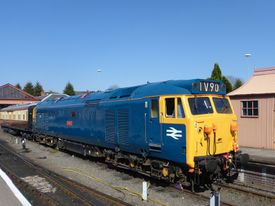BR Class 50 50044 Exeter
| BR Class 50 50044 Exeter | |
|---|---|
 50044 Exeter at Kidderminster, April 2017 | |
| Built By | English Electric Vulcan Foundry Works, Newton-le-Willows |
| Configuration | Co-Co |
| Power type | Diesel Electric |
| Status | Operational |
| Loco Number | 50044 |
| Other Numbers | D444 |
| History | |
| Built | 1968 |
| Designed By | English Electric |
| Type | Class 50 |
| 1991 | Purchased by Project Defiance |
| 2012 | Diesel engine damaged |
| 2018 | Returned to service |
| Technical | |
| Length | 68ft 6" |
| Weight | 115t |
50044 Exeter is a BR Class 50 diesel locomotive.
Contents
BR Class 50
Fifty English Electric Type 4 (later BR Class 50) diesel locomotives were built by English Electric at their Vulcan Foundry Works plant in Newton-le-Willows between 1967 and 1968. When built they were numbered in the D4xx series. They later became BR’s Class 50, being allocated TOPS numbers in the 50xxx series. The class was nicknamed “Hoovers” because of the distinctive sound of the inertial air-filters with which the locomotives were originally fitted.
Initially the locomotives were used to haul express passenger trains on the West Coast Main Line (WCML) between Crewe and Scotland; that section not then being electrified. This often entailed ‘Multiple Working’, with two locomotives under control of a single driver.
By 1974 the northern WCML had been electrified, and the Class 50 fleet was being transferred to BR’s Western Region to work main line passenger services out of London Paddington.
The Class 50’s did not originally carry names, but in the late 1970s BR agreed to their being named after Royal Navy vessels with notable records in the First and Second World Wars.
Withdrawal of the class began in the early 1990s.
50044 Exeter in service
D444 entered service at Stoke in November 1968, having been built as English Electric Works No 3814/D1185.
In May 1973 D444 was transferred to Crewe, being re-numbered 50044 in February 1974. Following electrification of the WCML, 50044 moved to Bristol in May 1974, before a move to Plymouth Laira in November 1980.
In April 1978, 50044 was named Exeter after HMS Exeter, a Royal Navy World War York Class Cruiser. Commissioned in 1931, HMS Exeter was involved in the Battle of the River Plate which resulted in the sinking of the German battleship Graf Spee. HMS Exeter was later sent to the East Indies where she was sunk by the Japanese in 1942.
50044 was withdrawn from service by BR in January 1991.
50044 Exeter in preservation
Following withdrawal, 50044 was sent to London’s Stratford depot for component recovery and later offered for sale as suitable for scrap only. The Fifty Fund were seeking a locomotive as a source of spares, but finding that few components had been removed, successfully purchased 50044 for preservation. It arrived from St Leonards on 6 May 1994 with 50031 Hood.[1] The locomotive has been cosmetically de-refurbished, to appear as it did when released to BR from English Electric's Vulcan Foundry works. Since its preservation 50044 has worked both on the SVR and on the main line.
Exeter was repainted in un-prototypical two tone green and rededicated by the Crew of HMS Exeter at Kidderminster in 2007. '44 has subsequently been repainted in BR Blue.
In 2012 a problem with oil temperature on a mainline railtour damaged 50044's diesel set. A replacement English Electric 16CSVT has been secured from Portugal (ex CP 1807) which was fitted with adjustments made to bring it in line with UK specifications. On 10 September 2018 50044 returned to passenger duty having received the overhauled engine and overhauled main, ETH and auxiliary generators.[2] It received a bogie overhaul in the Diesel Depot over the winter of 2019/20.
50044 Exeter on the main line in preservation
An incomplete list of main line appearances is as follows:
| Date | Tour name | Tour Operator | Route | Notes | Reference |
|---|---|---|---|---|---|
| 18 October 2008 | Rail Blue Charters | Manchester Piccadilly to Minehead | With 50049 Defiance and 57601 | [3] | |
| 9 May 2009 | The Cambrian Mountaineer | Spitfire | Bristol to Aberystwyth | [4] | |
| 3-4 September 2011 | The Snowdon Ranger | PTG Tours | London Euston to Holyhead | With 57304 Gordon Tracy | [5] |
| 19 November 2011 | The Edinburgh Explorer II | Spitfire | Preston to Edinburgh | With 50049 Defiance and 57001 | [6] |
| 21 July 2012 | GBRf | Cardiff-Paignton (private leg) - Plymouth | With 66720 | [5] |
See also
Diesel Locomotives
List of preservation groups
SVR-based diesel locomotives visiting other events
Locomotives running under different identities
References
- ↑ SVR Stock Book, ninth edition
- ↑ Severn Valley Diesels Official Facebook Group.
- ↑ Hondawanderer.com/Martin Loader Photography (Retrieved 21 January 2018)
- ↑ Renown Repluse Restoration Group website (Retrieved 21 January 2018)
- ↑ 5.0 5.1 Englishelectric.org website (Retrieved 21 January 2018)
- ↑ Hart M., ‘English Electric Class 40, 50 & 55 Diesel Locomotives’, Amberley Publishing Limited, April 2014
Links
Class 50 Alliance web site
50 Fund web site (still maintained)
| ||||||||||||||||||||||||||||||||||||||||||||||||||||||||||||||||||||||||
